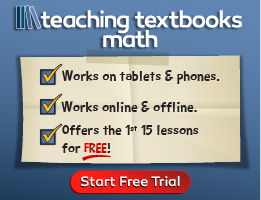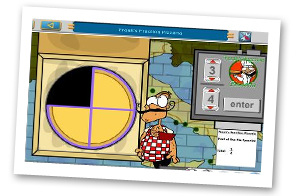Time4Learning is a website for homeschooling pre-kindergarten through high school that covers math, language arts, social studies, science, and electives. The elementary grades are built around CompassLearning Odyssey®, an online, interactive educational system that has been in existence for many years. Grades six through twelve are built on Subject.com courses that are used by many accredited traditional and charter schools across the U.S.Students pay a monthly membership fee.
Time4Learning is a curriculum provider rather than a school. That means they cannot be accredited, and they don't issue report cards or diplomas. Enrollment gives students access to courses for the four core subjects plus electives at upper levels.
Parents have their own login where they can set up student lesson plans and assignments as well as access records of student work. Student schedules and records can be printed out, and there's a form for creating a transcript.
Parents can select default grade-level programs and customize lessons and assignments within courses. Time4Learning will set up special configurations if needed. For example, you might have a child working at third-grade level in most subjects but fourth-grade for math.
The design of courses varies by both subject and grade level, generally combining animation, images, text, and response activities. Newer courses for the upper levels, called Cinema Series, feature video instructors who use stories, film footage, and images to make the courses engaging.
Some courses are fast moving, while others have lots of repetition and move more slowly. Both graphics and teaching methods are tailored to the age of the students and the content, with lots of variety within each course. However, for quick learners, there can be a lot of wasted time. While the courses teach the necessary content, lessons are slowed by cartoons and transitions. Also, concepts are taught, practiced and repeated, which is an appropriate teaching strategy, but sometimes there's too much repetition. For example, students answer math questions, and even if they answer correctly, the answer is restated by the computer and the explanation of why the answer is correct is given. It seems to me that the child who answers correctly should be able to move on without the reteaching. The redundancy might be helpful to some students and boring to others. On the other hand, students can review prior topics or retake lessons whenever necessary—a very helpful feature that is missing from some other online programs.
Some lessons have printable worksheets. If the screen shows “Resource” under the title of the activity, you can click to access a worksheet. Worksheets are also accessible through the Parent Dashboard section.
High school courses frequently use more traditional teaching methods than do lower-level courses, and many of them follow a similar pattern. They begin with a lesson presentation by a real person. Some courses use more creative lesson presentations, such as in English III where costumed actors portray authors of works to be studied. Whatever the style of the teacher, lessons are aided by computer graphics, images, and diagrams. Short lesson segments are followed by a one-screen summary of key points. Then students are presented with one or more practice questions to answer. A quiz usually wraps up each lesson.
Subject Area Coverage
Math coverage aligns with national standards for pre-K through twelfth grade, although that does not mean that courses cover everything required by your state. As the math starts to get more difficult, students will need to use paper and pencil to do some of their work offline, then enter their answers on the computer. For high school, students can choose to study Algebra I or II, Geometry, Advanced Math & Trigonometry, or Pre-Calculus. Time4MathFacts is available to students at all grade levels at no extra cost. Students practice addition, subtraction, multiplication, and division facts through games that adapt to challenge them at the appropriate levels.
Language arts courses include phonics and reading skills, comprehension, grammar, composition, vocabulary, and beginning handwriting (for Pre-K-2). They stress reading comprehension and fluency rather than phonics in the upper elementary grades and above. Older students also learn word roots, literary analysis, and critical thinking. Since the program is not able to evaluate student writing, it includes scoring guides for parents to evaluate writing assignments.
High school courses for language arts combine literary analysis with composition, vocabulary, reading comprehension, and communication skills. Students begin writing research papers in English I. Parents can allow the system to grade submissions or override automatic grading by evaluating students' compositions themselves.
Social studies begins in second grade. In the younger grades, social studies coverage is not intended to be complete, covering all the standards. A new Time4SocialStudies program for grades 3 through 5 uses an inquiry-based model, interactive maps, primary sources, and virtual experiences. Coverage is still a little lighter than some families might wish, and supplementing with historical fiction might work well. For grades 6 through 8, coverage is more thorough, including courses titled Ancient World History, World Cultures and Geography, and U.S. History. High school students can choose from five courses: U.S History, World History, and U.S. Government & Politics.
Science courses gradually ramp up the number of activities per grade level. but coverage is not intended to be comprehensive before sixth grade. Science for kindergarten through third grade incorporates lessons from Science4Us and includes 395 activities. While first grade has only 22 science activities, third grade has more than 200. Science is generally not a great concern in the earliest grade levels, so the fewer number of activities up through second grade should be sufficient. Fourth and fifth-grade science is presented through lessons on an assortment of topics, but it should be considered supplemental for these levels. (There are 172 science lessons—called activities in Time4Learning—for fourth grade and 220 for fifth grade.)
Beginning with sixth grade, middle school science is presented in three complete courses that align with state standards: Earth and Space Science, Life Science, and Physical Science, along with an Environmental Science elective. These courses combine thematic lessons with project-based learning to support concepts. They include some online and offline projects for students to complete. For high school, students can choose Biology, Chemistry, or Physics, which also include a lab component.
Middle school students can choose up to three elective courses from the following:
- Introduction to Art
- Introduction to Public Speaking & Communication
- Environmental Science
- Strategies for Academic Success
- Online Learning & Digital Citizenship
High school students also can choose three elective courses from the following options:
- Drawing I
- Photography I
- Introduction to Engineering
- Health Education
- Physical Education
- Financial Literacy I: Personal Finance
- Financial Literacy II: Budgeting & Investment
- Music Production and Digital Media
- Introduction to Computer Science
Time4Languages, foreign language learning powered by Rosetta Stone, is available for an additional fee, It offers instruction in your choice of English, Spanish, Chinese, Latin, French, German, Italian, Japanese, and Russian.
Assessment and Rewards
Quizzes and tests are built into each course to ensure comprehension. The program shows when students have completed activities, quizzes, and tests. Time4Learning has an automated reporting system that tracks test and lesson scores as well as the time spent on each activity. Parents can easily print weekly reports, customizing them by date, subject, or type of activity—a big help for record keeping and portfolio documentation. There are also tests that simulate standardized tests, although scores on those tests are not factored into the student’s achievement in Time4Learning.
Some of the material for pre-kindergarten through sixth grade seems rather easy for the designated grade level, with quizzes that students can pass with little effort. But this isn’t true all of the time. For example, math lessons for middle school are probably as demanding as most textbook-based courses.
Time4Learning also has an “online playground” for students in grades two through eight and a "game room" for high school students. Each level includes a timer that allows children to play these "safe" games for up to a time limit set by the parent. Playtime can be set to zero if parents don’t want children playing games at all. Games are actually ones that children will enjoy, and they might well be used as rewards to motivate children to learn.
You Also Need to Know...
The curriculum is secular and is tied to national and state standards to some extent, so you will encounter some of the same issues you would with any public school curriculum, particularly regarding evolution.
Since Time4Learning is not an actual school, they do not claim that courses meet all state or national standards. Parents and teachers can see how many hours a student spends on each subject, which is some help in determining whether or not they need to supplement, and Time4Learning offers free assistance that can help answer other questions about course content.
The Time4Learning website has many pages with details, screenshots, excerpts from lessons, course outlines, and other information that you can investigate to learn more.
Time4Learning provides support by phone, by email, and via chat.
In summary, Time4Learning is one of the most thoroughly developed educational websites. While it is possible to use it for a large part of your curriculum for some grade levels, you might need to use other resources alongside it for a complete program.









